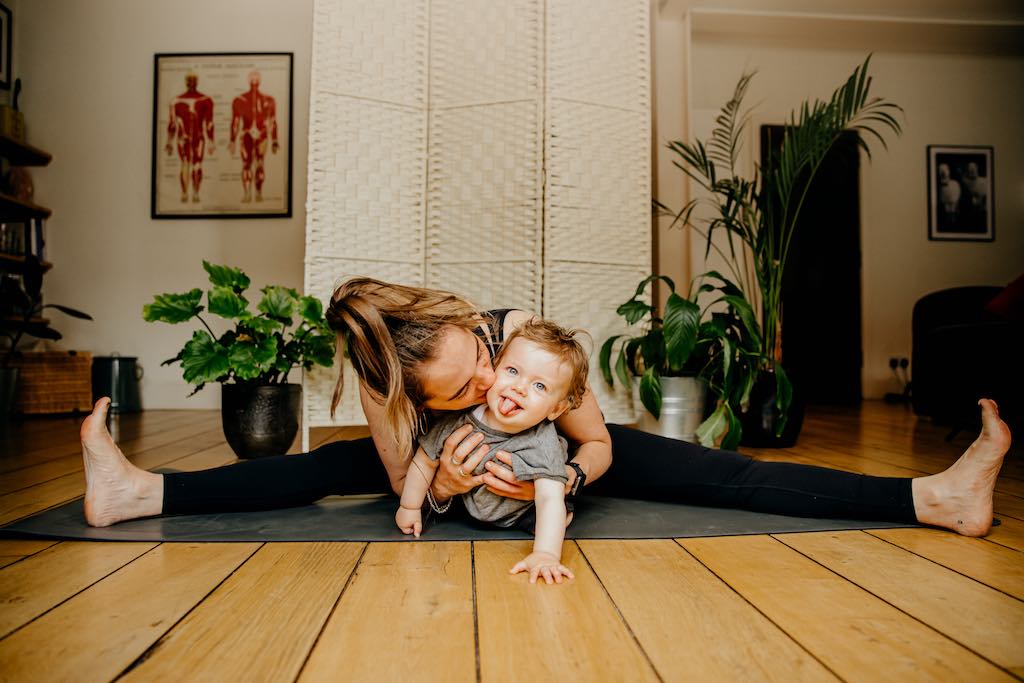The thing I found hardest about being a new mum was not having any time for myself. I was constantly on call for a tiny human who needed me 24/7. I couldn’t pop out to my local yoga studio after work or go for a run on my lunch break. Being a yoga and wellness teacher, it was a massive change and I felt restricted.

- Recovery from labour – our bodies go through a hell of a lot during labour; postnatal exercise can help strengthen your pelvic floor, strengthen your abdominal muscles and core muscle groups which may not have been used as much during pregnancy.
- Pelvic floor recovery – whether you had a C-section or vaginal birth, your pelvic floor needs to be strengthened again after you’ve had your baby. Think about this - your baby sat on your pelvic floor muscles for nearly a year! This is really important to prevent incontinence, improve prolapse and it can even make sex better!
- Releasing endorphins – happy mum, happy baby. Moving your body will help to release your ‘happy hormones’, which can help towards preventing postpartum depression.
- Time to bond with your baby – exercising with your baby can be a lovely way to bond, maybe you have them in a sling when they are very little, and hold them in your arms when they are a bit bigger. They will love watching you pull funny faces at them or having a nap in your arms.
- Time for you – whether your baby exercises with you or not, moving your body will help you regain some sense of self, essential for new mums.

So you know the benefits, now what?
- You must be signed off by a GP to exercise.
You will have a check-up appointment 6-8 weeks after your baby is born. After that you need to start gently, the hormone relaxin stays in the body up to 6 months after pregnancy and can make you feel more flexible than you really are. Your abdominal muscles may also be weaker and you may have something called diastasis recti (where the muscles in the midline of the abdomen separate), which is very common. All these things require you to ease yourself back in to exercise to avoid injury.
- Embrace the chaos!
Moving with your baby is not going to be the same as pre-baby. You might not be in a candlelit room where the only sound is singing bowls. Your baby might cry, want feeding or cuddling – and that’s OK! Embrace whatever happens each time you try some exercise.
- Set yourself up for success…
If exercising at home, grab baby’s playmat, a few of their favourite toys and a teether. If baby has a few things to occupy them during the session they’ll be happier. You can also keep a sling nearby to pop baby in if they get fussy.
- Even one minute of exercise is better than none!
You’ve set your baby up on the playmat, they’ve been fed and burped. You get onto your mat and… they start screaming their heads off! No amount of shaking that rattle is going to calm them down, they want cuddles with mummy. You’ve missed a whole part of the sequence on one side, disaster!
This is perfectly normal and part of postnatal exercise. Many of the women I teach pick up their baby at some point during the class to cuddle or feed them. Its highly likely you won’t do the entire class. Be adaptable, if you only manage 5 or 10 minutes of a class, that’s still better than nothing.
- Utilise rocking time
A simple idea is to swap out rocking your baby with standing exercises like lunges and squats – you are still moving baby around and they’ll probably really enjoy it if you add on some silly faces!


About the author:
Chrissie is a yoga teacher and pre and postnatal exercise specialist. She is also trained in Yin Yoga, Yoga Nidra and Level 3 Exercise on referral. She teaches online classes for new mums with her little boy Finley. Find her on Instagram as The Postnatal Yogi (the_postnatal_yogi).
References:
Focus Training: Level 3 Pre and Postnatal Exercise Instructor Manual
https://www.nhs.uk/conditions/baby/support-and-services/your-post-pregnancy-body/
https://www.nhs.uk/conditions/baby/support-and-services/keeping-fit-and-healthy-with-a-baby/

Leave a comment